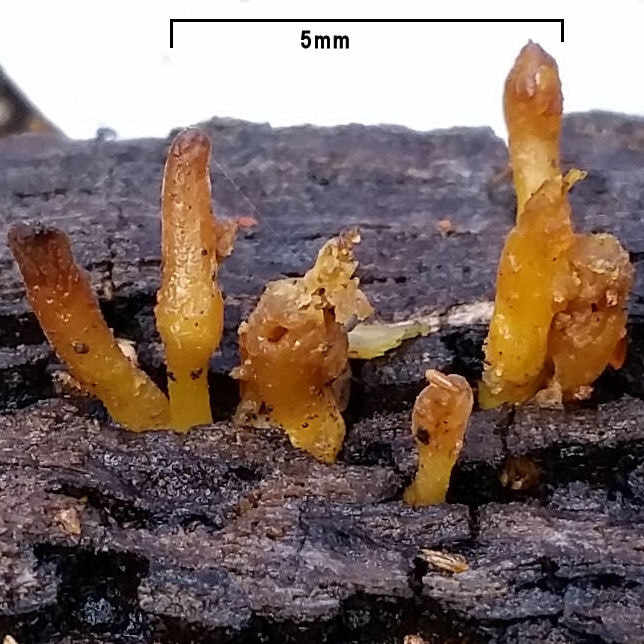Foxydoug's Guide to Narrogin Fungi
click on hyperlinks below for more images and information about these fungi
|
1 Agarics/Mushrooms and toadstools
Fleshy fruiting bodies with gills on the underside with a stem underneath or to the side. |
2 Boletes
Fleshy fruiting bodies with pores on the underside with a stem underneath or to the side. |
3 Polypores, Bracket, and Leather Fungi
Polypores are a little like boletes, in that they also have pores that are mouths of short, vertical tubes, but fruiting bodies are tough or woody. They may have stems (polypores) or be attached directly to wood (Bracket or Shelf Fungi). Leather fungi are polypores with thin-topped leathery fruiting bodies that may have stems or form fans with broad attachments. They are typically found on wood.
Polypores are a little like boletes, in that they also have pores that are mouths of short, vertical tubes, but fruiting bodies are tough or woody. They may have stems (polypores) or be attached directly to wood (Bracket or Shelf Fungi). Leather fungi are polypores with thin-topped leathery fruiting bodies that may have stems or form fans with broad attachments. They are typically found on wood.
4 Resupinates: Skin, Paint and Crust Fungi
Thin spore forming skins or layers generally on the underside of or inside dead wood.
Thin spore forming skins or layers generally on the underside of or inside dead wood.
7 Coral Fungi
Coral fungi are mushrooms that are usually shaped like coral, but can also be shaped like forks worms or clubs. They are rubbery with spores on external surfaces, and sometimes are brightly coloured. Ramaria gracilis commonly occurs under rock sheoaks. The larger cauliflower shaped Ramaria capitata was found only once emerging from the soil in rock sheoak/wandoo woodland.
Coral fungi are mushrooms that are usually shaped like coral, but can also be shaped like forks worms or clubs. They are rubbery with spores on external surfaces, and sometimes are brightly coloured. Ramaria gracilis commonly occurs under rock sheoaks. The larger cauliflower shaped Ramaria capitata was found only once emerging from the soil in rock sheoak/wandoo woodland.
8 Gelatinous club and jelly fungi are generally found on dead wood

10 Birds Nest Fungi
This fungus ((family Nidulariaceae (Nidulis -‘small nest)) feeds on decomposing organic matter has fruiting bodies that are tiny wonders of nature.
Being only a few millimetres in diameter, they are easily missed or mistaken for puffballs or slime mould spore balls.
The fruiting body starts like a mini puffball, before the membrane on top thins and breaks to reveal a cup containing ‘eggs’ called peridioles. Each peridiole contains spores and structure that produce them that are covered by a tough membrane. Raindrops falling directly into the cup splash the peridioles out of the cup on to grow.
Left: Cyathus olla Field Birds Nest
This fungus ((family Nidulariaceae (Nidulis -‘small nest)) feeds on decomposing organic matter has fruiting bodies that are tiny wonders of nature.
Being only a few millimetres in diameter, they are easily missed or mistaken for puffballs or slime mould spore balls.
The fruiting body starts like a mini puffball, before the membrane on top thins and breaks to reveal a cup containing ‘eggs’ called peridioles. Each peridiole contains spores and structure that produce them that are covered by a tough membrane. Raindrops falling directly into the cup splash the peridioles out of the cup on to grow.
Left: Cyathus olla Field Birds Nest
11 Leaf Lesions and Growth Distortion
This category is a mixed bag of diseases, and distortions that are caused by fungi, bacteria and viruses or some other hormonal disturbance associated with a genetic disorder (and possibly some insects).
More information: Witches Broom and Fasciation
This category is a mixed bag of diseases, and distortions that are caused by fungi, bacteria and viruses or some other hormonal disturbance associated with a genetic disorder (and possibly some insects).
More information: Witches Broom and Fasciation
12 Slime Moulds
These are not fungi, as instead of having fungal hyphae (like feeder 'roots'), they consist of a mass of individual cells or an amoeba-like slime that engulfs bacteria then comes together to form fungi-like or foamy fruiting masses.
More information and images - Foxypress slime moulds
These are not fungi, as instead of having fungal hyphae (like feeder 'roots'), they consist of a mass of individual cells or an amoeba-like slime that engulfs bacteria then comes together to form fungi-like or foamy fruiting masses.
More information and images - Foxypress slime moulds


















